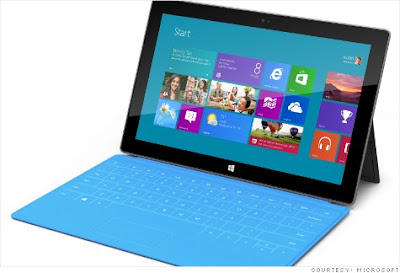 |
| Microsoft's $499 Surface,Microsoft's Surface,Microsoft's $499 Surface 2012 |
Is a Microsoft Surface tablet priced at $499 good enough to entice you away from that Apple iPad you might be considering?
That's the question Microsoft faces now that it has announced the prices of Surface with Windows RT, the company's first branded tablets, launching Oct. 26.
The tablet will come in at three price points, Microsoft said Tuesday:
• $499 for a 32-gigabyte version of the tablet.
• $599 for a 32GB version that comes with a black Touch Cover.
• $699 for a 64GB version that comes with a black Touch Cover
The Touch Cover — a thin tablet cover that doubles as a keyboard and attaches to the Surface magnetically — is one of Microsoft's key selling points for the tablet. The company is also selling the Touch Cover — which comes in black, white, magenta, cyan and red — separately for $119.99.
Microsoft also is selling separately the Type Cover — a slightly thicker Surface cover with moving keys that feel more like traditional keyboards. It will sell for $129.99 and come in black.
The Surface will be available for pre-order at www.surface.com, or for purchase starting Oct. 26 in Microsoft Stores, as well as the 34 holiday pop-up stores Microsoft is opening. It will also be available for sale online in the U.S., Australia, Canada, China, France, Germany, Hong Kong and the U.K.
The prices disclosed Tuesday are in line with what Microsoft executives hinted all along.
In the initial unveiling of the Surface in June, they said the price for the Surface RT would be comparable to other tablets. Apple's new iPad starts at $499 for the 16GB version.
And last month, Microsoft CEO Steve Ballmer said in an interview with The Seattle Times that the "sweet spot" in the bulk of the PC market would be between $300 and $700 to $800.
The Surface RT runs Windows RT, the version of Windows 8 designed to run on ARM-based processors. (Many of today's tablets, including the iPad, run on chips built on technology developed by ARM Holdings, a British company. ARM-based chips are notable for conserving on battery use.)
It comes with a version of Office installed that includes Word, PowerPoint, Excel and OneNote. It will not run legacy Windows apps.
Another version of the Surface tablet, Surface with Windows 8 Pro, is expected to launch in about three months. The Surface Pro will run on x86 processors produced by the likes of Intel and AMD and will be priced higher, comparable to ultrabooks, Microsoft executives have said. The Surface Pro will run Windows 8 and will run legacy Windows apps.
The Surface is Microsoft's first foray into making its own branded computing devices.
It's part of Microsoft's larger efforts — including the launch of Windows 8, also on Oct. 26 — to gain a foothold in the mobile market.
Whether it can break through and get people's attention enough for them to try out and buy it is the big question.
Ads for Surface have already started running.
And though the prices announced Tuesday are "not as aggressive as I would've liked to have seen them get," said Tom Mainelli, an analyst with research firm IDC, "I think it's competitive."
One challenge will be the limited number of places where people can get their hands on a Surface — namely, Microsoft's retail and temporary holiday pop-up stores.
"I think a lot of people would really like to be able to try out that keyboard before they pull the trigger," Mainelli said.
Another challenge comes in the number of apps available in the Windows Store, which lags far behind the number for the iPad.
Still, if reports are accurate, it sounds like Microsoft plans to sell a lot of Surfaces.
The Wall Street Journal, citing component suppliers in Asia, reports Microsoft has placed orders to produce 3 million to 5 million Surface tablets in the fourth quarter.
"That's a big number," said Mainelli, who notes Amazon shipped 5 million of its Kindle Fire tablet when it launched last year and Google's Nexus 7 has shipped close to 2 million to date. Apple sold 17 million iPads last quarter.
The challenge Microsoft faces is not necessarily the Surface's price point, said Michael Gartenberg, an analyst with research firm Gartner.
"We know consumers will spend $499 for something they want," Gartenberg said. What Microsoft has to do is convince consumers that "this is different. And why different is better.
"This is a huge challenge for Microsoft in terms of not only getting the product right but also the message and the marketing right," Gartenberg said. "The challenge is directly with the iPad, which is very much perceived by consumers as the base choice. Microsoft has to convince them they're not buying into the wrong platform."
There's another big shadow hanging over Surface: Apple announced Tuesday an event on Oct. 23. It's expected the company will announce an iPad Mini, a smaller — and presumably cheaper — version of its tablet market-dominating iPad.
Though the Surface aims to be a different tool — more productivity-oriented — than the smaller and less expensive 7-inch tablets such as Kindle Fire and the expected iPad Mini, it still will compete with the companies that produce them.
That's because the larger battle now is not merely between devices. Those devices are simply ways for consumers to access the large array of services the companies provide and a way for those companies to keep selling services to customers.
"It's not iPad vs. Surface vs. Nexus," Gartenberg said. "It's the Microsoft ecosystem vs. the Google ecosystem vs. the Apple ecosystem."
No comments:
Post a Comment